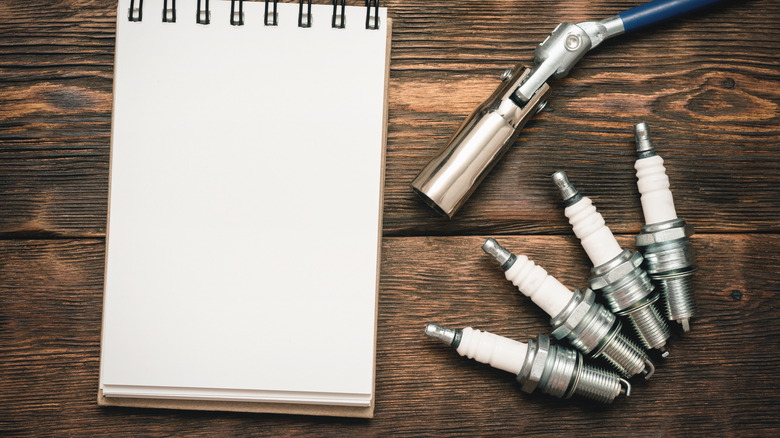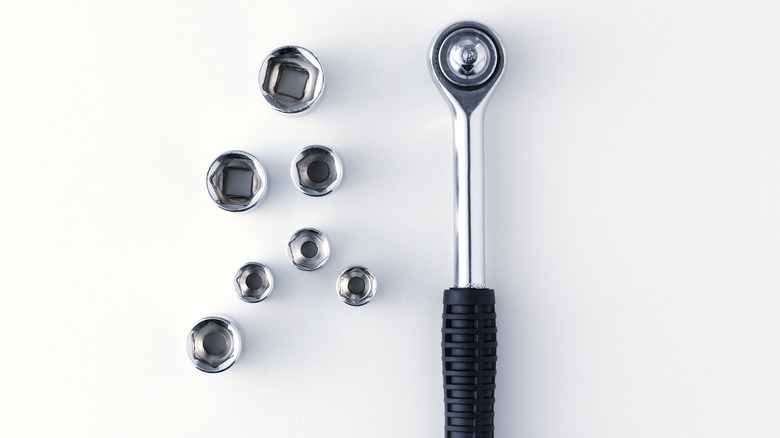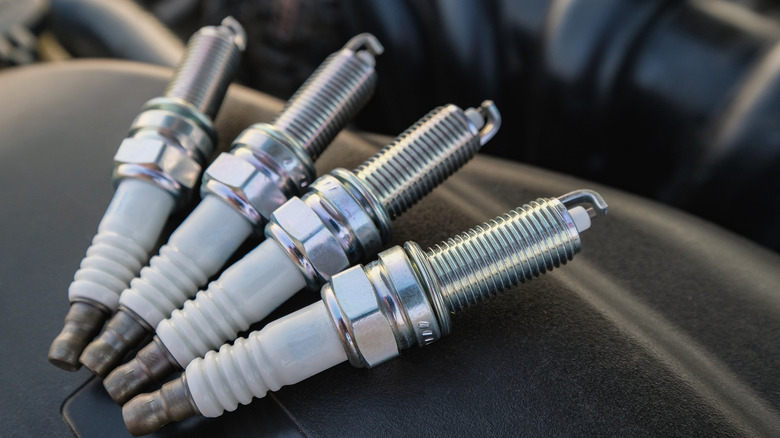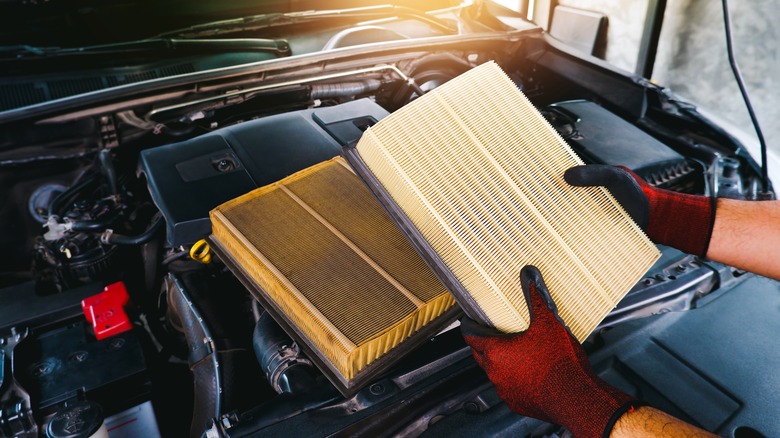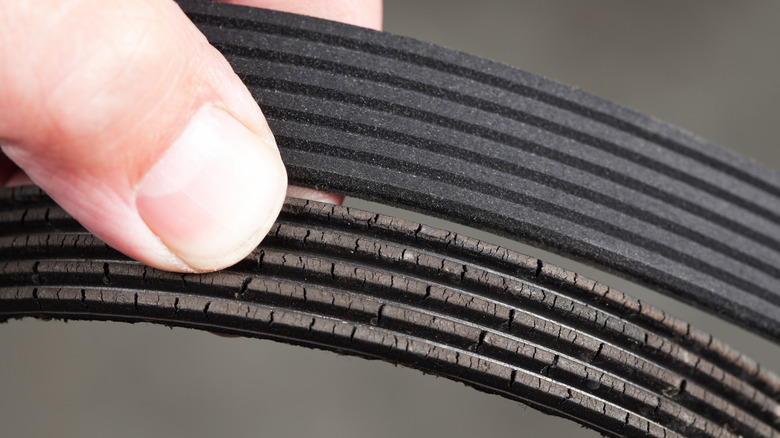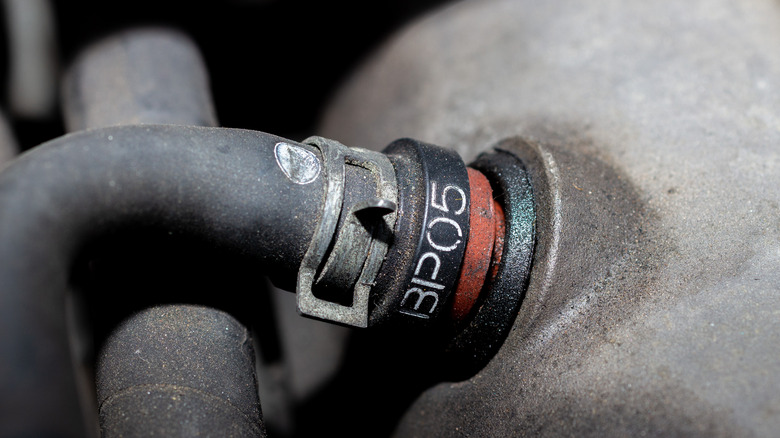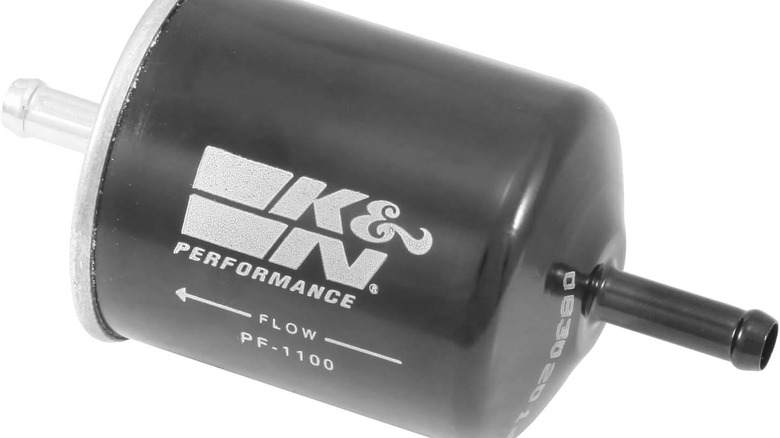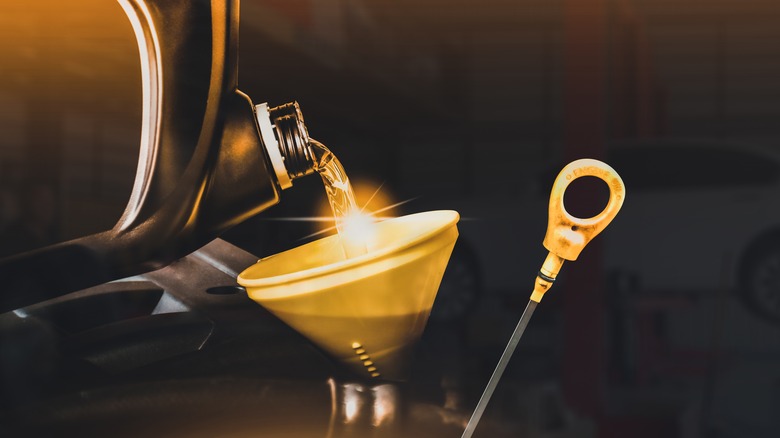Everything You'll Need To Complete A Basic Engine Tune-Up
We may receive a commission on purchases made from links.
Owning a vehicle is an expensive undertaking, especially with the cost of gas on the rise again. Repairs can also be costly and difficult to estimate, which is why many car owners take on routine repairs and maintenance tasks themselves.
Even after you factor in the cost of tools, parts, and other necessary supplies, doing regular jobs like oil changes, coolant system flushes, and tune-ups can save you thousands of dollars over your vehicle's lifespan. A full tune-up can help improve gas mileage and performance and even help extend the life of your engine. The term "tune-up" is somewhat outdated, as it harkens back to the era when most vehicles had carburetors and ignition points and required frequent adjustments to timing and fuel/air mixture to keep them running efficiently. Modern cars and trucks have computerized fuel injection and ignition systems that don't require as much fiddling but still respond well to regular maintenance.
A tune-up for modern cars and trucks will consist of checking and replacing some key components that wear out over time. You'll want to consult your owner's manual or call your dealership's service department to identify the proper interval for changing all the parts listed here on your vehicle. Let's review all the necessary tools, parts, and supplies for this routine maintenance.
Tools and supplies
If you don't already have a basic set of automotive tools, now is the time to begin gathering them. You'll need sockets and a ratchet handle with extensions and a universal joint to get to hard-to-reach places, wrenches, screwdrivers, and pliers (there are many varieties of this tool: at the very least, you should have a set of needle-nose pliers, some channel-lock style pliers, and a pair of vise-grip style locking pliers. Many older American-made cars and trucks use SAE (inch-based) fasteners, but foreign and most modern domestic vehicles use metric nuts and bolts, so a set of metric sockets and wrenches should be appropriate for most uses.
You'll also want to purchase a spark plug socket in the correct size for the plugs that go in your car. A spark plug socket has a rubberized insert so the ceramic neck of the plug isn't damaged during installation, and it often also comes with a built-in universal joint to make access to awkward locations easier.
You'll also want a magnetic tray or coffee can to hold small parts and fasteners, some rags or shop towels, and a pad and pen to take notes and draw diagrams as you work. Having your smartphone charged and close by to take photos for reference is also a good idea. Depending on your vehicle's ground clearance, you might also need a jack and jack stand to get underneath it safely. (NEVER go under your vehicle without supporting it in at least two different places and choking the wheels to keep it stable). Now, it's time to start gathering the parts you'll be swapping out during the tuneup process.
Spark plugs and related parts
Each cylinder in your car's engine relies on a spark plug to ignite the fuel/air mixture inside. The force from the resulting explosion pushes the piston down and rotates the crankshaft, providing the power that eventually goes to the wheels. As spark plugs become fouled with carbon and damaged by heat, your car's ability to burn fuel efficiently suffers, leading to diminished performance and lowered fuel economy.
Changing your spark plugs is a critical part of the tuneup process and will provide a good return on the investment of a few dollars per plug. Consult your owner's manual or call your dealership's service department to identify the correct spark plug and gap setting to use in your vehicle; many modern engines require platinum or iridium plugs. While you're at the parts store picking up new plugs, grab a gap tool as well; you may have noticed these small silver discs near the register; there are also blade-style gap tools (also known as feeler gauges) available at Amazon or Harbor Freight.
Most older vehicles use a component called a distributor to send spark to each cylinder over an array of wires. If your vehicle has a distributor, you'll also need a set of plug wires, a new distributor cap and rotor, and some dielectric grease (most wire kits include a small packet of this clear gel).
Most modern vehicles use coil packs on each cylinder instead of a distributor; again, consulting your owner's manual or calling your dealership's service department should help you determine which system your vehicle uses. Your local auto parts supplier should also be able to help you identify what components you need for your car or truck.
Air filters
Another part that requires regular replacement is your air filter. The engine air filter helps keep dirt, dust, and other contaminants out of the fuel system, keeping your engine running at its best. Check your owner's manual to see the recommended interval for changing the air filter in your vehicle. Typically, a good guideline is to replace it every 12,000 to 15,000 miles or once a year or more if you often drive on dirt roads or in sandy or dusty environments.
Swapping out your engine air filter can usually be done in a few minutes without much effort on most cars, and the filters for many cars cost less than $20. Your vehicle may have an engine air filter and a separate cabin air filter: the engine air filter will usually be mounted in a plastic housing under the hood with hoses leading from the air intake and to the throttle body, while the cabin air filter is often located behind the glove compartment, under the dashboard, or along the firewall. The cabin air filter cleans the air flowing through the ductwork of your car's climate control system; when it comes time to replace it, you might notice a musty smell inside your car.
Belts and hoses
Tuneup time is a great time to inspect and replace the belts and hoses under your hood as well. The crankshaft pulley turns the belts at the front of your engine and drive accessories like the alternator, power steering pump, and air conditioner compressor. These belts can become worn and cracked from temperature changes and exposure to moisture, and a broken alternator belt will leave you stranded before too long. Many modern vehicles use one long belt (called a serpentine belt) that drives all the engine accessories; it's a good idea to carry a spare one of these in your car at all times in case it snaps unexpectedly. You can watch videos on YouTube or 1AAuto.com for step-by-step instructions on how to change the belts on your vehicle. Often, having a second set of hands to help manipulate engine accessories to put proper tension on belts using a pry bar or long screwdriver is helpful. When installed, you should be able to deflect a belt about 1/2 of an inch at its longest stretch point.
This is also a good time to inspect your radiator hoses for cracks and leaks. If you have pets, be very careful when draining and disposing of used antifreeze/coolant: the taste of ethylene glycol is enticing to cats and dogs and can cause fatal poisoning, even in small amounts.
You'll also have an array of vacuum hoses that channel air from your intake manifold to various parts of your engine, like the brake booster, EGR (Exhaust gas recirculation) valve, and heater controls. Cracked or loose vacuum hoses can cause strange noises under the hood, compromise vehicle performance, or even light your check engine light.
PCV valve, grommet, and hoses
One component that might not come to mind immediately when you start the tuneup process is your car's PCV (Positive Crankcase Ventilation) valve. The PCV valve helps recirculate unburned hydrocarbons through your car's intake system, helping reduce emissions. A clogged PCV valve can cause oil leaks, a dirty exhaust, and may even cause the check engine light on your dashboard to signal an issue. On most cars, the PCV valve is mounted in a rubber grommet in the engine's valve cover. There will be a hose leading to the valve attached with a hose clamp; if you're replacing the valve, be sure the hose and grommet are in good condition as well. This means they are still pliable and free of cracks and splits. Hoses, PCV valves, and grommets can usually be replaced for a few dollars each, although the grommets are sometimes hard to get seated properly in the valve covers.
Fuel filter
Tune-up time is also a good time to change your fuel filter. Your fuel filter works to sift out small particles from the gas or diesel fuel in your car, and over time, the paper element in the filter will become filled with dirt and other debris. A clogged fuel filter will inhibit engine performance and reduce your fuel mileage. Some fuel filters are installed in a fuel line using hose clamps, while others are screwed into a mount on the engine in the same manner as an oil filter.
If you have an inline fuel filter, it may be located under the hood or along the frame rail near the rear of the vehicle. Before changing your fuel filter, it's important to de-pressurize your fuel system.
Some cars have a release valve on the fuel rail that you can press or turn to release fuel pressure; on other vehicles, you'll have to remove the fuel pump relay and run the engine until the fuel system is drained of fuel. If you have to relieve pressure via a valve, be sure to cover the area with a rag or towel to avoid spills and make sure to disconnect the battery before working with fuel lines to reduce the risk of fire.
Oil and filter
Another very important routine engine maintenance task is changing your oil and oil filter. It used to be necessary to change engine oil every 3,000 miles, but many modern cars can go 5,000, 7,500 miles, or even longer between oil changes. Consult your owner's manual or dealership service department for the proper oil change interval for your vehicle, as well as the correct type and weight of oil to use. Many newer cars use require synthetic oil, which will have a longer interval between changes than conventional oil. It's important to use the correct type and weight oil for your engine; oil viscosity (thickness) is measured on a scale from zero to 60, with zero being the thinnest and lightest. Most modern commercial oils have two viscosity measurements separated by the letter W; the first number indicates the oil's viscosity when cold, and the second number when it is warmed to operating temperature.
To change your oil, you'll need the appropriate amount of fresh oil to fill the crankcase, a filter and filter wrench, a socket or wrench to remove the drain plug, a funnel, and a drain pan. Most chain auto parts stores will accept used oil for recycling, and you can probably also take it to your local public works recycling or hazardous waste disposal facility.
